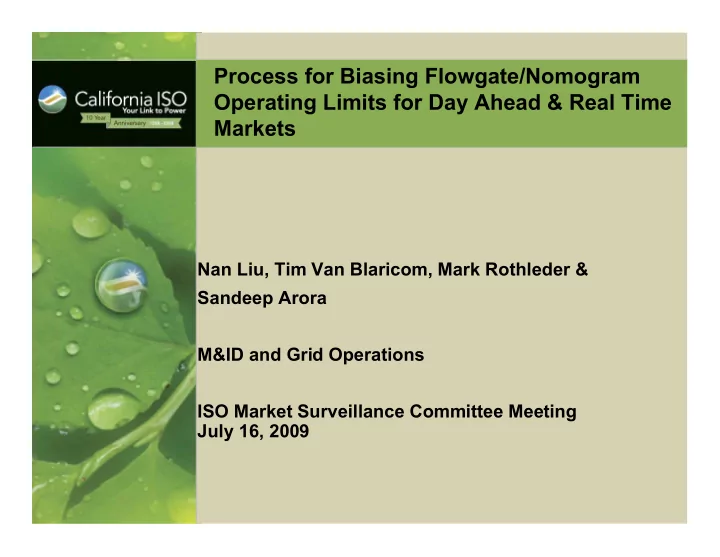

Process for Biasing Flowgate/Nomogram Operating Limits for Day Ahead & Real Time Markets Nan Liu, Tim Van Blaricom, Mark Rothleder & Sandeep Arora M&ID and Grid Operations ISO Market Surveillance Committee Meeting July 16, 2009
Outline Biasing Process Key reasons for Biasing needs Biasing & Constraint Enforcement Pre vs Post LMP Market Biasing Examples California ISO Public Slide 2
Biasing Process: Key points Biasing done only on an as needed basis for DA & RT runs Biasing done only for select flowgates (currently only about 30 flowgates are actively biased out of approximately 5000 total flowgates) No scheduling limits altered as part of biasing process RTM biasing requirements depend on congestion experienced in Real Time & DAM uses RT biasing levels as one of the inputs to determine DA biasing levels. California ISO Public Slide 3
Key Reasons for Biasing needs 1. To align market flows with actual flows 2. To accommodate mismatch due to inherent design differences of DAM, RTUC and RTD 3. To allow reliability margins 4. To adjust margins for flowgates impacted by telemetry issues. California ISO Public Slide 4
Key Reason #1: Biasing to align market & actual flows Reasons for flow anomalies (market vs actual): Unscheduled flow Difference in Load Distribution Resource Deviations External network model limitations Network modeling differences California ISO Public Slide 5
Key Reason # 2: Biasing to accommodate inherent design of DAM, RTUC & RTD runs Different optimization intervals for different market runs- DAM – 1 hr RTUC – 15 min RTD – 5 min Level of biasing in DAM will depend on level of predictable conditions that are forecast to arise in RTM Level of biasing in RTUC will depend on Real-Time condition but in general RTUC bias >= RTD bias. California ISO Public Slide 6
Key Reason # 3: Biasing to maintain Reliability Margin Reasons why reliability margins are needed for select flowgate constraints: Contingency Reserve procurement & constrained transmission AGC awards & dispatch may worsen some transmission constraints Intermittent resource deviations – DA schedules vs RT dispatch for intermittent resources may worsen transmission constraints Adverse Operating conditions in Real Time. California ISO Public Slide 7
Key Reason # 4: Biasing to account for Telemetry Issues Due to lack of telemetry some constraints are “un- enforced” until actual loading condition arise If PTO reports a violation or if SE Solution shows a violation, constraint may need to be enforced in the market, with a bias Going forward, increased telemetry may be needed. California ISO Public Slide 8
Constraint Enforcement & Biasing: Pre vs Post LMP Market Pre-LMP Market: In Day Ahead, no Intra-zonal flow-limit constraints enforced; only Inter-Zonal scheduling limits enforced In Real Time, Reliability Margins for Intra-zonal constraints were maintained using OOS dispatches. Post-LMP Market: A majority of Intra-Zonal & Inter-Zonal flow-limit constraints & all Scheduling limit constraints are enforced in Day Ahead & Real Time Biasing done in Day Ahead and Real Time, on an as needed basis. California ISO Public Slide 9
Biasing Examples Assuming A = Normal limit for a flowgate B = Calculated market flow (from closest RTD) C = Actual flow (from telemetry) If biasing needed, then new flow limit is calculated by the formula: D (New limit for the flowgate) = A – (C – B) Also, the Bias Percentage for this flowgate is calculated by the formula: E (Bias %) = 100 * D/A Example 1. If, A = 500, B = 475, C = 550. Then, D (New flow limit for the market) = 425. E (Bias %) = 85% Example 2. If, A = 500, B = 525, C = 475. Then, D (New flow limit for the market) = 550. E (Bias %) = 110% California ISO Public Slide 10
Questions ? California ISO Public Slide 11
Recommend
More recommend